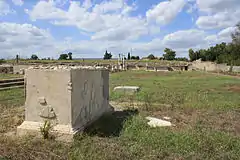Feronia (Etruria)
Feronia or Lucus Feroniae (Φερωνία, Strabo; Λοῦκος Φηρωνίας, Ptolemy) was an ancient town of southern Etruria, at the foot of Mount Soracte, within the territory of Capena, with a temple or shrine of the goddess from whom it derived its name, and a sacred grove, attached to it. Strabo, indeed, is the only author who mentions a town of the name, which he calls Feronia;[1] other writers speak of Lucus Feroniae and Feroniae fanum, but it is natural that in process of time a town should have grown up around a site of so much sanctity, and which was annually visited by a great concourse of persons. Feronia appears to have been a Sabine goddess,[2] and hence the festivals at her shrine seem to have been attended especially by the Sabines, though the sanctuary itself was in the Etruscan territory, and dependent upon the neighbouring city of Capena [3] The first mention of these annual festivals occurs as early as the reign of Tullus Hostilius, when we find them already frequented by great numbers of people, not only for religious objects, but as a kind of fair for the purposes of trade, a custom which seems to have prevailed at all similar meetings.[4] Great wealth had, in the course of ages, been accumulated at the shrine of Feronia, and this tempted Hannibal to make a digression from his march during his retreat from Rome, in 211 BCE, for the purpose of plundering the temple. On this occasion he despoiled it of all its gold and silver, amounting to a large sum, besides which there was a large quantity of rude or uncoined brass, a sufficient proof of the antiquity of the sanctuary.[5] The only other notices of the spot which occur in history are some casual mentions of prodigies that occurred there;[6] but Strabo tells that it was still much frequented in his time, and that many persons came thither to see the miracle of the priests and votaries of the goddess passing unharmed through a fire and over burning cinders.[7] This superstition is ascribed by other writers to the temple of Apollo, on the summit of Mount Soracte.[8] It was probably transferred from thence to the more celebrated sanctuary at its foot.

The general position of the Lucus Feroniae is sufficiently fixed by the statements that it was in agro Capenate, and at the foot of Mount Soracte. A fountain at the foot of the hill of Sant'Oreste, near the southeast extremity of the mountain, is still called Felonica. As such fountains were generally connected with sacred groves, there is every probability that this was the site of the grove and sanctuary of the goddess. The village of San Oreste, which stands on the hill above (a shoulder or offshoot of Soracte), and bears some traces of having been an ancient site, is thought by Antonio Nibby and George Dennis to occupy the position of the ancient town of Feronia.[9]
Pliny mentions a Lucus Feroniae among the colonies of the interior of Etruria and from the order in which he describes the towns of that province, there can be little doubt that he means the celebrated locality of the name in southern Etruria. But it is singular that Ptolemy, who also notices a Lucus Feroniae, to which he gives the title of a colonia, places it in the northwest extremity of Etruria, between the Arnus (modern Arno) and the Macra. [10] No other notice occurs of any such place in this part of Etruria; and the Liber Coloniarum, though unusually copious in its description of the province of Tuscia, mentions no such colony at all. An inscription, on the other hand, in which we find the name of Colonia Julia Felix Lucoferonensis[11] refers probably to the southern Etruscan town, and on the whole it is more probable that the name should have been altogether misplaced by Ptolemy, than that there should have existed a second colony of the name, of which we know nothing.[12]
References
- (v. p. 226.
- Varro, De lingua Latina v. 74.
- Livy i. 30, xxvii. 4.
- Livy i. 30; Dionys. iii. 32.
- Livy xxvi. 11; Silius Italicus xiii. 83-90.)
- Id. xxvii. 4, xxxiii. 26.
- Strabo v. p. 226.
- Pliny the Elder vii. 2; Virgil Aeneid xi. 785-790).
- Antonio Nibby, Dintorni, vol. iii. p. 108; Dennis, Etruria, vol. i. p. 180.
- Ptol. iii. 1. § 47; Plin. iii. 5. s. 8.
- Orell. 4099.
- August Wilhelm Zumpt, De Coloniis p. 347.
Sources
 This article incorporates text from a publication now in the public domain: Smith, William, ed. (1854–1857). Dictionary of Greek and Roman Geography. London: John Murray. Missing or empty
This article incorporates text from a publication now in the public domain: Smith, William, ed. (1854–1857). Dictionary of Greek and Roman Geography. London: John Murray. Missing or empty |title=(help)